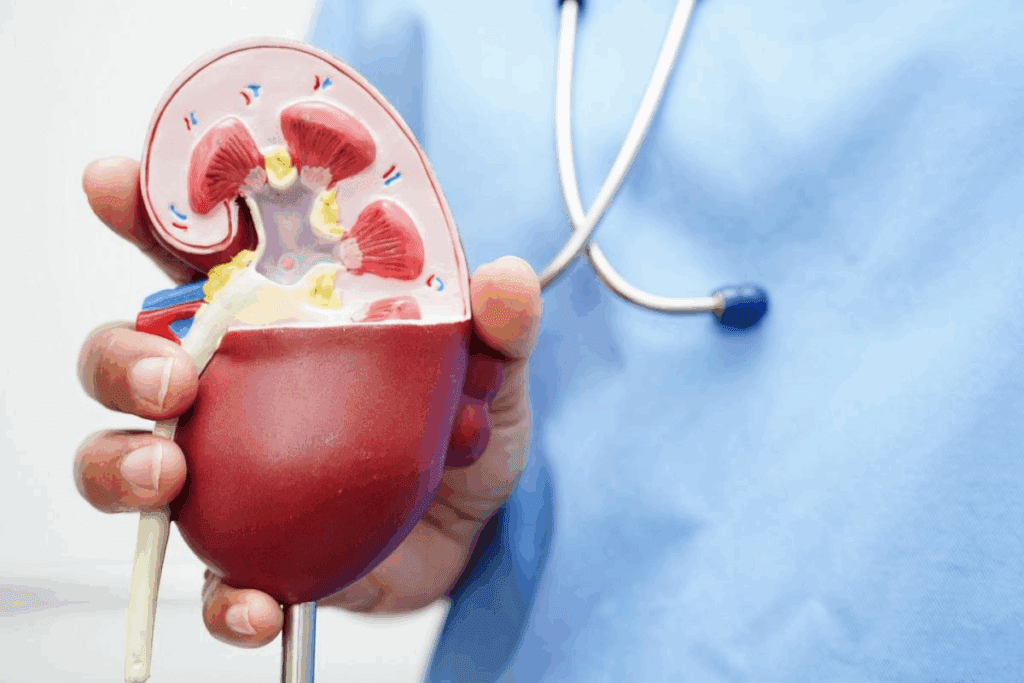
Calcium phosphate kidney stones are a big part of kidney stone problems. They are caused by special reasons and risk factors. This is why we see more of them.
These stones form when urine is too alkaline. They can also come from health issues like hyperparathyroidism or renal tubular acidosis. Knowing why they happen helps us find ways to stop them.

Calcium phosphate kidney stones form due to many factors, like metabolic conditions and genetics. They are different from other kidney stones. We will look at their makeup, types, and how they appear, including their spiky shapes.
Calcium phosphate stones are made mainly of calcium phosphate minerals. These minerals can form in different ways. The main types are:
These stones can look different, with some having spiky formations. These spiky shapes can hurt the kidney more.
Calcium phosphate stones are different from other stones, like calcium oxalate stones. They form in different ways and under different conditions. For example:
Knowing these differences helps in finding better ways to prevent and treat them. Studies show that about 10% of people worldwide get calcium stones, including calcium phosphate, at some point in their lives.

Recent studies show a big jump in calcium phosphate kidney stones over the last few decades. This trend is seen all over the world, hitting different groups hard. It’s a big worry for doctors everywhere.
The spread of calcium phosphate stones is complex. It’s influenced by diet, environment, and genes. Stones are on the rise in many places, with different rates.
To grasp these trends, let’s look at some study data:
| Region | Increase in Ca Phosphate Stones (%) | Time Period (Years) |
| North America | 25 | 10 |
| Europe | 30 | 15 |
| Asia | 40 | 20 |
Women are seeing a bigger rise in calcium phosphate stones. Hormonal shifts, like those in menopause, might play a role. Knowing this helps us target prevention better.
There’s a shift in kidney stone types, with calcium phosphate stones on the rise. This change comes from diet, lifestyle, and possibly genes. We must keep watching these changes.
By studying these shifts, we can find the causes and improve treatments. This means focusing on prevention and care tailored to each patient’s needs.
Calcium phosphate kidney stones form due to several key factors, including urine pH. This process involves many steps, from crystal formation to stone growth.
The formation of calcium phosphate stones starts with crystal nucleation. Calcium and phosphate ions in the urine come together to form a solid crystal nucleus. An alkaline urine environment helps this process, as it makes calcium phosphate less soluble.
“The supersaturation of urine with calcium phosphate is a critical factor in the nucleation of crystals.”
After a crystal nucleus forms, it grows by adding more ions. The growth rate depends on urine supersaturation and the presence of inhibitors or promoters.
Crystals can join together to form larger stones. This happens due to urinary stasis, low urine volume, and substances that help crystals stick together. The stone development process is also influenced by other urinary substances that can either help or hinder growth.
Calcium phosphate stones grow faster and larger because of alkaline urine. Researchers say, “The high pH environment not only promotes the formation of calcium phosphate crystals but also facilitates their rapid growth.” This environment, along with other metabolic factors, leads to aggressive stone growth.
Understanding why these stones grow quickly is key to managing them. By addressing metabolic disorders and urinary pH issues, healthcare providers can prevent these stones from forming and growing.
Understanding urine pH is key to knowing how calcium phosphate kidney stones form. Urine pH greatly affects the formation of these stones. It influences the precipitation of calcium phosphate crystals.
An elevated urine pH makes the environment more alkaline. This promotes the formation of calcium phosphate crystals. When urine is more alkaline, calcium phosphate becomes less soluble. This leads to crystal formation and eventually stones.
Alkaline urine also influences the type of crystals formed. In an alkaline environment, hydroxyapatite, a form of calcium phosphate, is favored.
Several factors can make urine more alkaline. These include:
These factors can increase urinary pH. This increases the risk of forming calcium phosphate stones.
Calcium phosphate crystallization is highly pH-dependent. Research shows that a urine pH above 6.2 significantly increases the risk of stone formation. At this pH, calcium phosphate solubility decreases, making crystallization easier.
| Urine pH | Risk of Calcium Phosphate Stone Formation |
| < 6.2 | Lower risk |
| > 6.2 | Higher risk |
In conclusion, urine pH is a critical factor in calcium phosphate kidney stone formation. Knowing what affects urine pH and keeping it optimal can help prevent these stones.
Metabolic factors are key in the formation of phosphate kidney stones. They can greatly raise the risk of calcium phosphate renal calculi.
Hyperparathyroidism makes the parathyroid glands work too much. This leads to too much parathyroid hormone (PTH). PTH controls calcium in the blood. Too much of it causes high calcium levels in urine, raising the risk of calcium phosphate stones.
Key effects of hyperparathyroidism on calcium phosphate stone formation:
Renal tubular acidosis (RTA) messes with the kidneys’ acid-base balance. RTA makes urine too alkaline. This makes calcium phosphate more likely to form stones.
The main features of RTA that contribute to stone formation are:
Other metabolic disorders can also lead to calcium phosphate stones. These include:
As noted by
“The presence of metabolic disorders significantly complicates the management of calcium phosphate stones, necessitating a thorough treatment approach.”
— Expert in Nephrology
Knowing these metabolic causes is vital for treating calcium phosphate renal calculi effectively.
Genetics play a big role in getting phosphate renal calculi. Some genetic conditions make you more likely to get kidney stones, like calcium phosphate ones.
Dent’s disease is a rare genetic disorder. It affects the kidneys and can cause kidney stones. This happens because the kidneys can’t absorb calcium and other substances well.
People with Dent’s disease often get kidney stones over and over. They might also get chronic kidney disease. Doctors find this condition by testing for CLCN5 gene mutations.
Other genetic conditions can also lead to phosphate renal calculi. These include:
These conditions change the urine, making it easier for calcium phosphate to form stones.
For those who keep getting kidney stones, genetic testing can help. It’s good for people with a family history of stones or who get stones early. Finding genetic links can guide treatment and prevention.
Genetic tests can spot conditions like Dent’s disease and others that raise the risk of phosphate stones. Knowing this helps doctors treat better and lower the chance of more stones.
The table below lists genetic conditions linked to phosphate renal calculi:
| Genetic Condition | Key Features | Gene Involved |
| Dent’s Disease | Proximal tubule dysfunction, low molecular weight proteinuria, hypercalciuria | CLCN5 |
| Primary Hyperparathyroidism | Hypercalcemia, hyperparathyroidism | Multiple genes |
| Renal Tubular Acidosis (Type 1) | Metabolic acidosis, hypokalemia, hypercalciuria | SLC4A1, ATP6V1B1, ATP6V0A4 |
UTIs can change the urine’s environment, leading to calcium phosphate crystals. These infections raise the risk of kidney stones, including calcium phosphate ones.
UTIs change urine’s chemical makeup, making it more likely for calcium phosphate stones to form. Bacteria in the urine can make it more alkaline. This change helps calcium phosphate crystals form.
Key changes in urinary chemistry due to UTIs include:
Distinguishing between struvite and pure calcium phosphate stones is important. Struvite stones are made of magnesium ammonium phosphate and are linked to infections. Pure calcium phosphate stones have their own formation process.
| Characteristics | Struvite Stones | Pure Calcium Phosphate Stones |
| Composition | Magnesium ammonium phosphate with possible calcium phosphate components | Primarily calcium phosphate |
| Association with UTIs | Strongly associated with urease-producing bacteria | Can be associated with UTIs, but not exclusively |
| Urinary pH | Typically forms in alkaline urine | Forms in alkaline urine |
Urease-producing bacteria are key in forming certain stones, like struvite and calcium phosphate. These bacteria make the urine more alkaline by breaking down urea.
Knowing how UTIs and these bacteria affect stone formation is vital. It helps us prevent and treat stones more effectively. By treating the infection and adjusting urine chemistry, we can lower the risk of stones coming back.
Understanding dahllite, the hydroxyapatite form of calcium phosphate, is key for diagnosing and treating kidney stones. It forms in the kidneys and is linked to certain metabolic conditions. Identifying and analyzing dahllite is vital for effective patient care.
Dahllite has a unique crystal structure, similar to hydroxyapatite. This structure helps it grow and stay stable in the kidneys. The properties of dahllite, like its hardness and chemical resistance, make it a key part of some kidney stones.
The formation of dahllite is influenced by several factors, including urine pH and other minerals. Alkaline urine helps calcium phosphate crystals form, leading to dahllite stones.
Dahllite forms in the kidneys due to metabolic and environmental factors. Conditions like hyperparathyroidism and renal tubular acidosis raise the risk of dahllite stones by changing urine chemistry.
The ions and pH level in urine are key to dahllite formation. Knowing these factors is vital for preventing dahllite stones from coming back.
Identifying dahllite in kidney stone analysis uses techniques like X-ray diffraction and infrared spectroscopy. These methods help figure out the stone’s composition and guide treatment.
Accurate dahllite identification is essential for creating targeted treatment plans. Knowing the stone’s composition helps healthcare providers suggest the right preventive measures and therapies.
Calcium phosphate stones in the kidneys can harm renal health. These deposits can damage kidney tissue and cause nephrocalcinosis. This can lead to long-term health problems for patients.
Calcium phosphate deposits can block the renal tubules. This blockage can damage the surrounding tissue. Nephrocalcinosis, a condition where calcium salts deposit in the kidneys, can also occur.
Tubule plugging can cause localized damage and even acute kidney injury. Nephrocalcinosis can lead to chronic damage, affecting kidney function over time.
Phosphate stone formation can have severe long-term effects. Repeated stone formation can lead to chronic kidney disease (CKD). CKD can progress to end-stage renal disease, requiring dialysis or a transplant.
Different kidney stones can cause different levels of damage. Calcium phosphate stones are known for causing significant damage. They tend to form in the renal tubules and cause blockages. Other stone types, like uric acid stones, may cause less direct damage but can also lead to serious health issues if not managed properly.
| Stone Type | Tissue Damage Potentia | Common Complications |
| Calcium Phosphate | High | Tubule plugging, Nephrocalcinosis |
| Uric Acid | Moderate | Acute kidney injury, CKD |
| Struvite | High | Urinary tract infections, Sepsis |
In conclusion, kidney damage from calcium phosphate deposits is a serious concern. It can lead to significant long-term health issues. Understanding the mechanisms of damage is key to developing effective prevention and treatment strategies.
It’s important to know why calcium phosphate kidney stones form. We’ve talked about how metabolic disorders, genetic factors, and infections play a role. These factors can increase your risk.
To prevent and manage these stones, we need a few steps. Eating less phosphate and drinking more water can help. Doctors might also give you medicine to keep your urine pH balanced and lower calcium and phosphate levels.
Changing your lifestyle is also key. Keeping a healthy weight and managing health issues can help. These steps can lower your chance of getting more stones. Always talk to a doctor to find the right treatment for you.
Calcium phosphate kidney stones are made of calcium and phosphate minerals. They often take the form of hydroxyapatite or dahllite.
Hormonal differences, like the effect of estrogen, might make calcium phosphate stones more common in women.
Dahllite is a type of hydroxyapatite, a mineral that can form kidney stones.
Alkaline urine helps calcium phosphate crystals form, raising the risk of stones. Diet and health conditions can change urine pH.
The pH level for calcium phosphate crystallization is usually 6.5-7.0. But, it can vary based on individual factors.
Hyperparathyroidism and renal tubular acidosis can increase the risk of calcium phosphate stones. They affect mineral metabolism and urine chemistry.
Bacteria, like those that produce urease, can change urine chemistry. This promotes calcium phosphate crystallization and stone formation.
Struvite stones are linked to infections and contain magnesium ammonium phosphate. Pure calcium phosphate stones are mainly calcium and phosphate.
Yes, genetic conditions like Dent’s disease can increase the risk of phosphate kidney stones. They affect kidney function and mineral metabolism.
Repeated phosphate stone formation can damage kidneys. It can lead to tubule plugging and nephrocalcinosis, affecting kidney function over time.
To prevent and manage calcium phosphate stones, change your diet, take medications, and make lifestyle changes. These can reduce the risk of stones coming back.
Genetic testing can find genetic conditions that cause repeated stone formation. It helps in creating targeted treatments and prevention plans.
Black kidney stones are usually calcium phosphate or other minerals. They can show previous stone episodes or other health issues.
Yes, spiky kidney stones are often calcium phosphate stones. They have a spiky or irregular shape.
National Center for Biotechnology Information. (2025). What Causes Calcium Phosphate Kidney Stones Calcium phosphate. Retrieved from https://pmc.ncbi.nlm.nih.gov/articles/PMC3192488/
Subscribe to our e-newsletter to stay informed about the latest innovations in the world of health and exclusive offers!
WhatsApp us